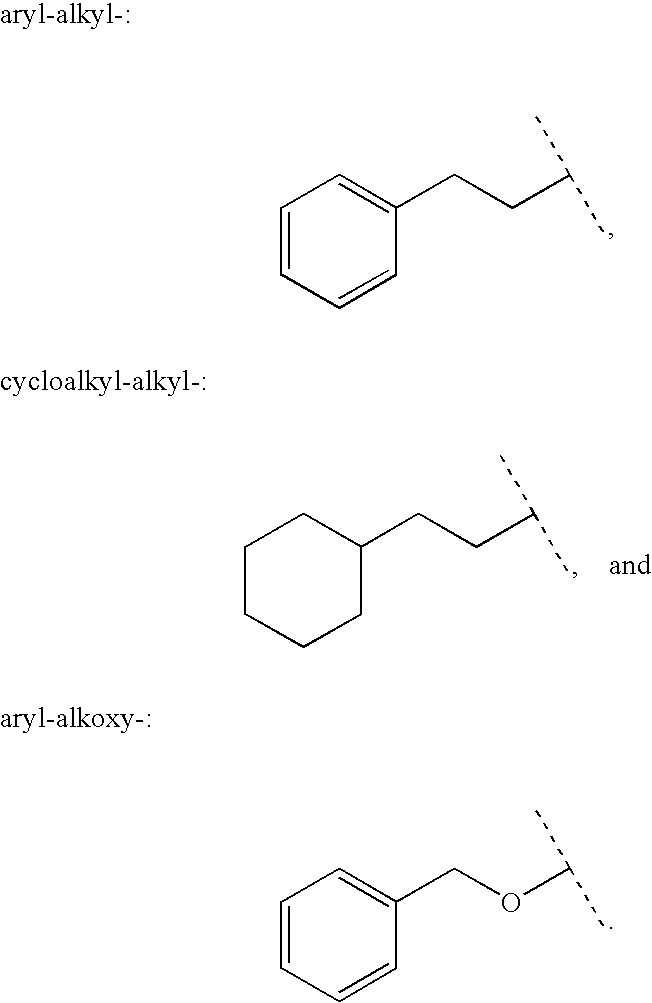Aryl carbonyl derivatives as therapeutic agents
a technology of aryl carbonyl and derivatives, applied in the field of compounds, can solve the problems of high risk of diabetic complications, poor treatment effect, and insatiable patients, and achieve the effects of improving the ability of patients to respond to treatment, and improving the effect of treatment
- Summary
- Abstract
- Description
- Claims
- Application Information
AI Technical Summary
Benefits of technology
Problems solved by technology
Method used
Image
Examples
example 1
N-(2-Phenoxyphenyl)-N′-(thiazol-2-yl)urea
[2174]
[2175]N-(2-Phenoxyphenyl)-N′-(thiazol-2-yl)urea (0.59 g, 94.9%) was prepared from 2-phenoxyaniline (0.37 g, 2.00 mmol) and 2-aminothiazole (0.20 g, 2.00 mmol) following the general procedure D.
[2176]LC-MS (m / z): 313 (M+1)+.
[2177]1H NMR (400 MHz, acetone-d6): δ 6.76 (d, J=13.8 Hz, 1H), 6.98-7.04 (m, 4H), 7.11 (t, J=4.8 Hz, 2H), 7.32 (t, J=8.0 Hz, 2H), and 8.35 (dd, J=1.6, 8.0 Hz, 1H), 10.2 (br, 2H).
example 2
N-[2-(2,3-Dimethoxyphenoxy)-5-Fluorophenyl]-N′-(thizol-2-yl)sulfamide
[2178]
[2179]To a solution of sulfuryl chloride (2.0 ml, 2.0 mmol, 1.0 M solution in dichloromethane) were added p-nitrophenol (0.55 g, 4.0 mmol) in dichloromethane and N,N-diisopropylethylamine (0.71 ml, 4.0 mmol) at −78° C. The reaction mixture was stirred for 1 hour at −78° C. and 2-(2,3-dimethoxyphenoxy)-5-fluoroaniline (0.52 g, 2.0 mmol) in dichloromethane (5 ml) was added. The reaction mixture was stirred for 10 min and 2-aminothiazole (0.2 g, 2.0 mmol) was added. The reaction mixture was allowed to warm up slowly to ambient temperature. The mixture was concentrated under reduced pressure. The residue was dissolved in ethyl acetate and was washed (dil. NaOH, water, brine), dried (Na2SO4) and concentrated under reduced pressure. The crude product was treated with Dowex-50 acidic resin in ethyl acetate-methanol (1:1) to remove unreacted 2-aminothiazole. The filtrate was concentrated and the residue was purified ...
example 3
1-(2-phenoxyphenyl)-5-(thiazol-2-yl)biuret
[2182]
[2183]To a solution of 2-phenoxyaniline (0.46 g, 2.50 mmol) in tetrahydrofuran (20 ml) was added diisopropylethylamine (0.89 ml, 5.00 mmol) and the solution was cooled to −30° C., then N-(chlorocarbonyl)isocyanate (0.3 ml, 3.75 mmol) was slowly added. The mixture was then allowed to warm up to the room temperature during 30 min. 2-Aminothiazole (0.375 g, 3.75 mmol) was added to the reaction mixture and stirred at room temperature for 6 hours. The reaction mixture was concentrated under reduced pressure to afford crude product, which was purified by silica gel chromatography (hexanes:ethyl acetate from 80:20 to 30:70) to afford title compound (0.49 g, 55%) as pale yellow solid.
[2184]LC-MS (m / z): 356 (M+1).
[2185]1H NMR (400 MHz, acetone-d6): δ 6.92 (dd, J=1.6, 7.6 Hz, 1H), 7.06 (m, 5H), 7.40 (m, 3H), 8.32 (d, J=4.8 Hz, 1H), 8.45 (d, J=5.6 Hz, 1H), 9.02 (br, 1H), 9.78 (br, 1H), and 10.46 (br, 1H).
PUM
 Login to View More
Login to View More Abstract
Description
Claims
Application Information
 Login to View More
Login to View More - R&D
- Intellectual Property
- Life Sciences
- Materials
- Tech Scout
- Unparalleled Data Quality
- Higher Quality Content
- 60% Fewer Hallucinations
Browse by: Latest US Patents, China's latest patents, Technical Efficacy Thesaurus, Application Domain, Technology Topic, Popular Technical Reports.
© 2025 PatSnap. All rights reserved.Legal|Privacy policy|Modern Slavery Act Transparency Statement|Sitemap|About US| Contact US: help@patsnap.com



